Key takeaways:
- Serverless architecture liberates developers from server management, enabling rapid deployment and cost efficiency.
- Challenges include cold start issues, complexity in monitoring/debugging, and potential vendor lock-in, impacting user experience and migration flexibility.
- Best practices emphasize function granularity, resource management, and automation, significantly enhancing development efficiency and performance.
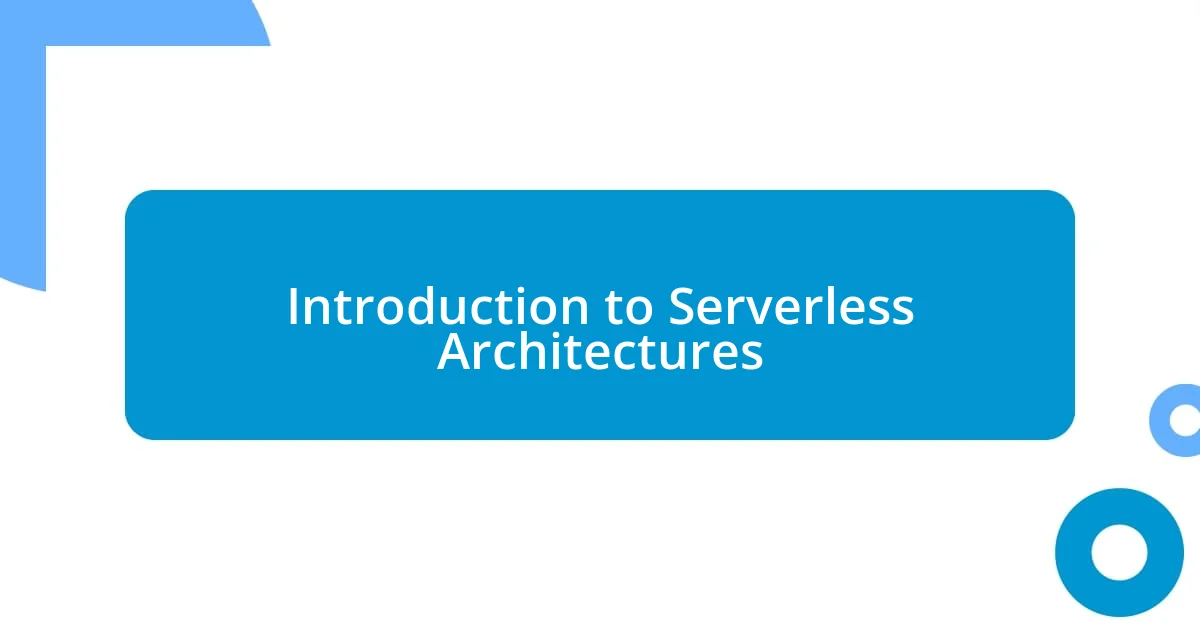
Introduction to Serverless Architectures
Imagine a world where you can focus solely on your code without the hassle of managing servers. That’s the beauty of serverless architecture. It allows developers like me to build applications without worrying about the underlying infrastructure, letting creativity and innovation take the front seat.
When I first ventured into serverless computing, I felt a sense of liberation. Gone were the late nights dealing with server configurations and scaling issues. Instead, I could deploy features rapidly and respond to user needs almost in real time. Isn’t it exciting to think how quickly you can iterate on your ideas when server management isn’t holding you back?
Of course, serverless doesn’t mean that no servers are involved—it’s more about how we use them. You pay only for what you use, making it a cost-efficient choice for many projects. But it does come with its own set of challenges, like vendor lock-in. Have you ever felt the thrill of letting go of cumbersome tasks, even while keeping an eye on potential drawbacks? That’s the balance we all strive for.
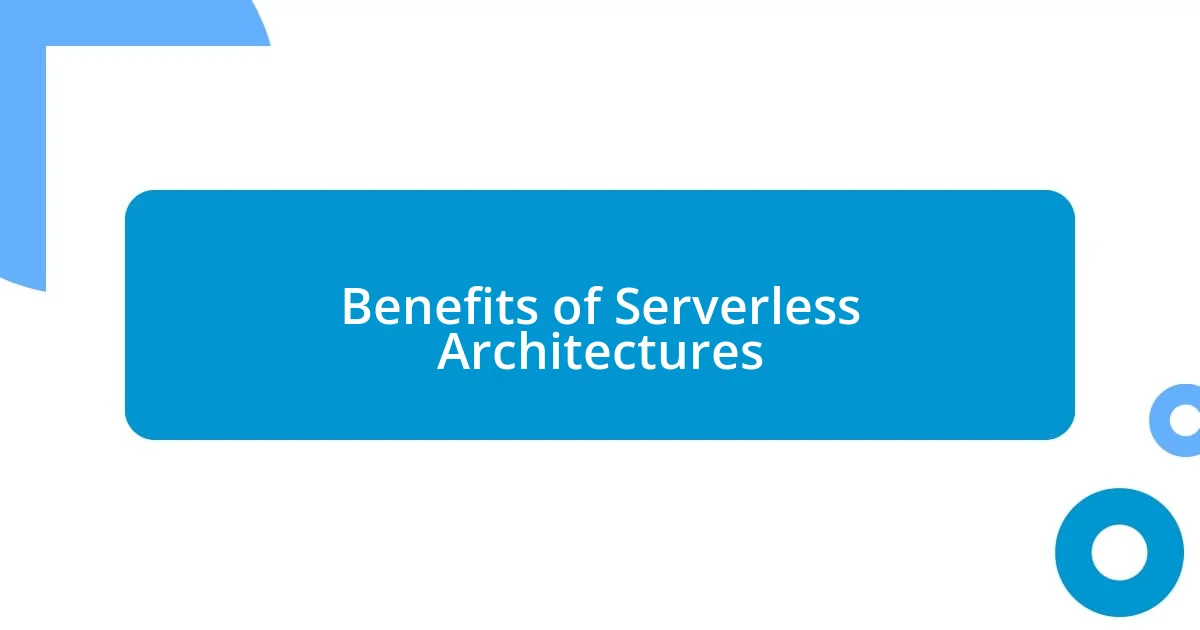
Benefits of Serverless Architectures
One of the standout benefits of serverless architectures is the sheer scalability it offers. I remember a particular project where user traffic spiked unexpectedly, and rather than panicking, I watched as the service auto-scaled to handle the load. There’s a sense of satisfaction knowing that the infrastructure can adapt in real-time, allowing me to focus on crafting an outstanding user experience rather than worrying about backend limitations.
Furthermore, serverless can significantly cut down operational costs. With a pay-as-you-go model, you only incur expenses based on actual usage. This aspect can be particularly advantageous for startups or small teams that want to maximize their resources. Here are some of the key benefits:
- Cost efficiency: Pay for what you use, minimizing waste.
- Reduced management overhead: Focus on code instead of infrastructure maintenance.
- Rapid deployment: Roll out features quickly without lengthy setup.
- Built-in high availability: Automatically handle traffic spikes effortlessly.
- Streamlined development: Simplifies the path from development to production, enhancing agile practices.
Embracing a serverless architecture can feel like unlocking new potential, and I’ve found that the ability to iterate quickly leads to more fruitful experimentation and innovation.
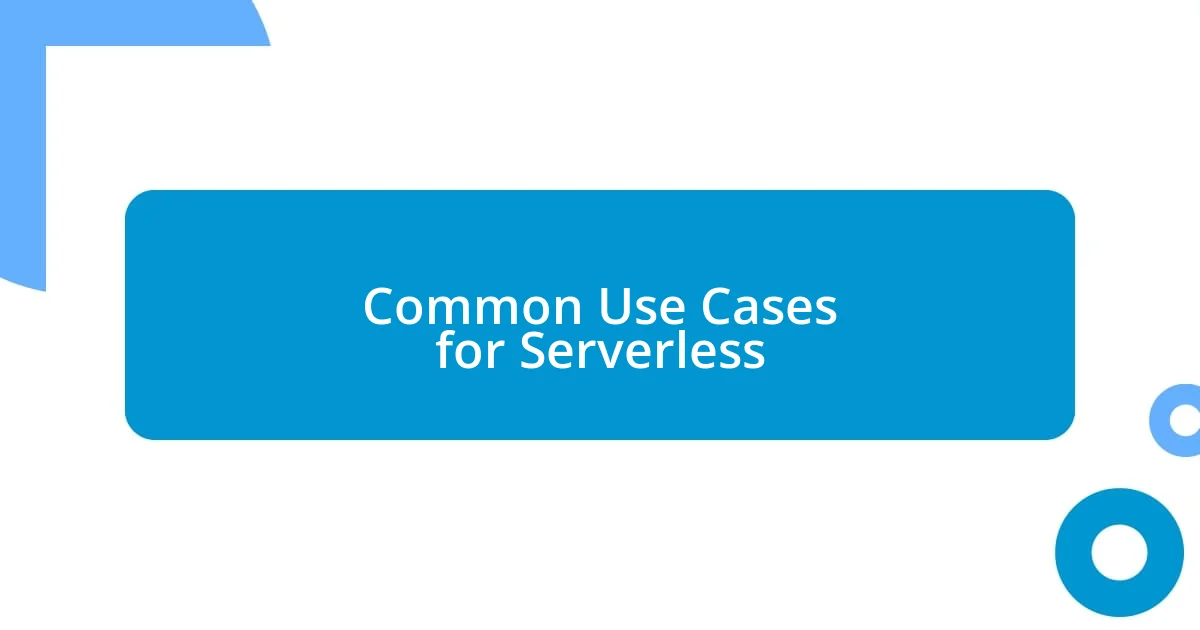
Common Use Cases for Serverless
Serverless architectures are particularly well-suited for building APIs and microservices. I vividly recall a project where we developed a lightweight REST API using AWS Lambda. It was a refreshing experience, as deployment became as simple as pushing a new function. This simplicity allowed my team to iterate on features quickly, all while maintaining a smooth user experience. Have you ever had a moment when everything just clicks into place? That sensation is what serverless can bring to API development.
Another compelling use case is event-driven applications. During one of my early projects, we implemented an event system to handle user registrations. As users signed up, various events triggered a chain of serverless functions, updating our database, sending welcome emails, and even starting user onboarding workflows. The elegance of it all was staggering! It felt almost magical to witness such seamless integration without the typical server-side constraints.
Lastly, serverless shines in automating background tasks like data processing and file uploads. I remember a time when a client needed to process large amounts of uploaded images. Instead of setting up a dedicated server, we employed a serverless approach that triggered functions to automatically resize and optimize images. The efficiency and reduced complexity were game changers, allowing us to focus our efforts on other critical tasks without missing a beat.
| Use Case | Description |
|---|---|
| APIs and Microservices | Lightweight services that can rapidly evolve and scale based on demand. |
| Event-Driven Applications | Applications that perform actions based on triggered events, streamlining workflows. |
| Background Task Automation | Automatic processes for tasks like data manipulation, reducing manual overhead. |
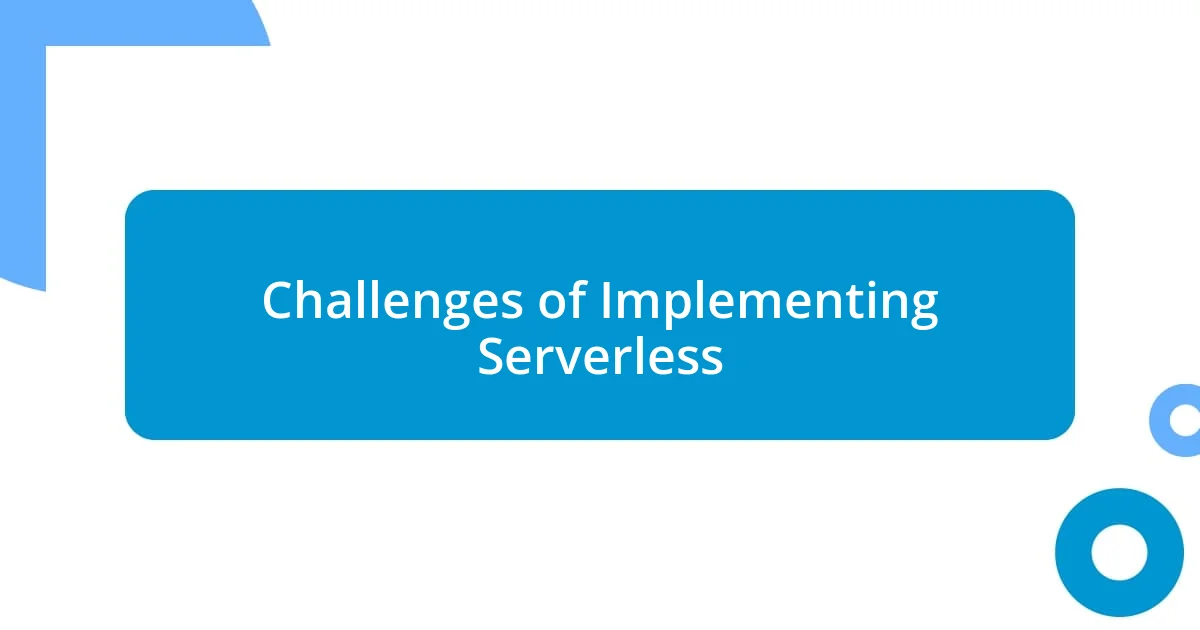
Challenges of Implementing Serverless
Implementing serverless architectures isn’t all smooth sailing, and I’ve faced my fair share of challenges along the way. One significant hurdle I encountered was the cold start issue. When I first deployed functions on platforms like AWS Lambda, I was shocked to see delays during the initial execution. It’s frustrating when your application’s responsiveness is compromised, especially during peak times when users expect instant gratification. Have you ever had a moment where a technical glitch almost ruined the experience for your users? That was my reality until I learned how to optimize my functions effectively.
Another stumbling block I’ve run into is the complexity of monitoring and debugging in a serverless environment. Unlike traditional architectures where I might have direct access to server logs, tracing issues in a fragmented system can feel like searching for a needle in a haystack. I remember a day spent tracking down a seemingly simple bug that turned into an epic quest for information. I found myself wishing for better tooling that could provide more insights into function performance. It’s challenging to maintain visibility when you’re disconnected from the infrastructure, right?
Lastly, I often think about vendor lock-in. While it’s tempting to jump into a specific serverless platform because of its features, I’ve become more conscious of how difficult it can be to migrate later. I once had a project that depended heavily on one cloud provider’s unique services. The moment I realized that replicating the same functionality on another platform would require extensive rewrites, my initial excitement turned into anxiety. I believe it’s essential to weigh the benefits against potential limitations before committing to a single vendor, as the freedom to pivot can be crucial in our fast-moving tech landscape.
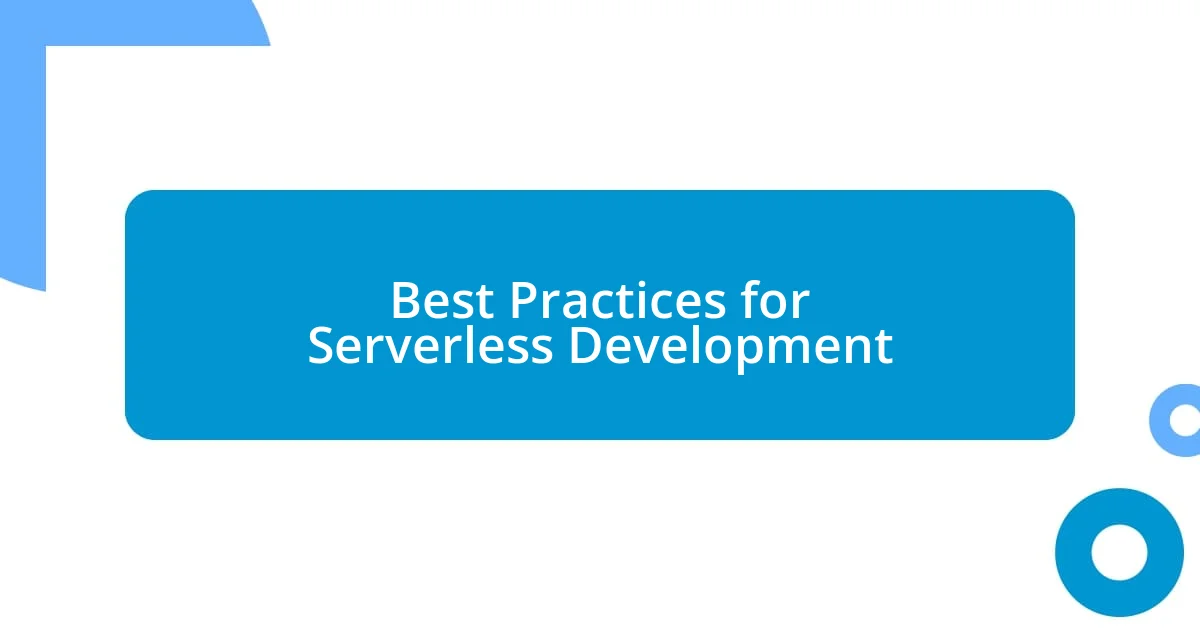
Best Practices for Serverless Development
When diving into serverless development, it’s crucial to prioritize function granularity. I remember the initial thrill of bundling multiple functionalities into a single Lambda function, only to discover later that it complicated our deployment process. Breaking down functions into smaller, focused tasks not only enhanced maintainability but also improved our scaling capabilities. Have you ever noticed how a cluttered workspace hinders productivity? The same principle applies here; simplicity breeds efficiency.
Another essential practice is managing your resources wisely. I’ve learned that setting appropriate timeout limits and memory allocations can greatly influence performance. There was one instance when I underestimated the memory required for a data-intensive operation, leading to execution failures. The lesson? Always monitor your resource usage and adjust accordingly; it can make all the difference in ensuring your functions run smoothly. Have you thought about how often we overlook the little details until they become big problems?
Lastly, embracing automation in your development workflow is a game changer. Incorporating CI/CD tools for deployment drastically reduced the manual overhead I faced in previous projects. I recall a moment when I automated the testing phase for our functions, and it was like turning a light switch on—I could finally focus on coding rather than babysitting deployments! You’ll be amazed at how much smoother your development cycle becomes when you let automation handle the repetitive tasks. It’s as if you get to reclaim precious time for innovation.
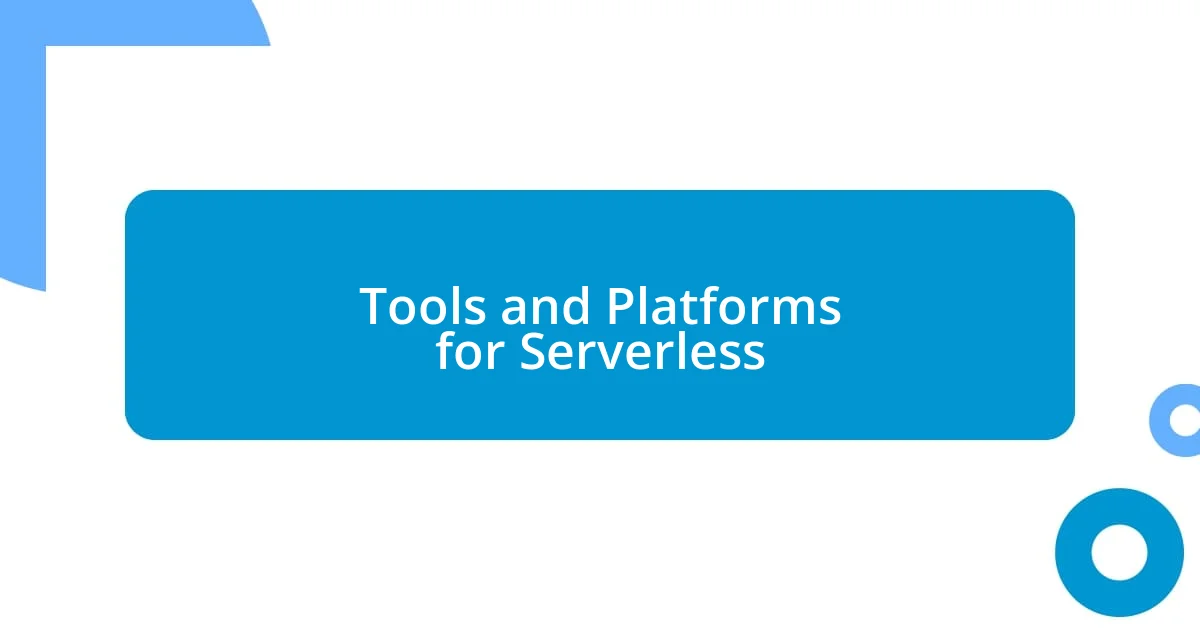
Tools and Platforms for Serverless
When discussing tools for serverless architectures, AWS Lambda often comes to mind first. During my early days with serverless, I found Lambda to be incredibly intuitive, but I also wrestled with its extensive ecosystem. There were moments when I felt overwhelmed trying to navigate all the services available and how they worked together. Have you ever spent hours just figuring out which tool was the right fit for your project? It can be a daunting process.
Azure Functions also caught my attention later on. I remember trying to integrate some existing Azure services into my serverless setup, and the seamless connectivity was a game changer. That experience heightened my appreciation for platforms that truly support developers through built-in integrations. I often wonder how much easier our lives could be if every platform made it as straightforward as Azure does—what if we didn’t have to constantly patch together disparate services?
Tying everything together with the right monitoring tools is essential as well. I learned the hard way that overlooking tools like AWS CloudWatch can lead to blind spots in performance tracking. There was a challenging sprint where I was completely unaware of an error threshold being crossed until users reported downtime. The moment I set up alerts to monitor function invocations, I felt a burden lift—it’s hard to sleep at night knowing your app is running smoothly. That proactive approach not only gave me peace of mind but also ensured I could respond quickly to potential issues. What are the kind of insights you would love to have at your fingertips during development? Knowing that answer can make all the difference in optimizing your serverless experience.
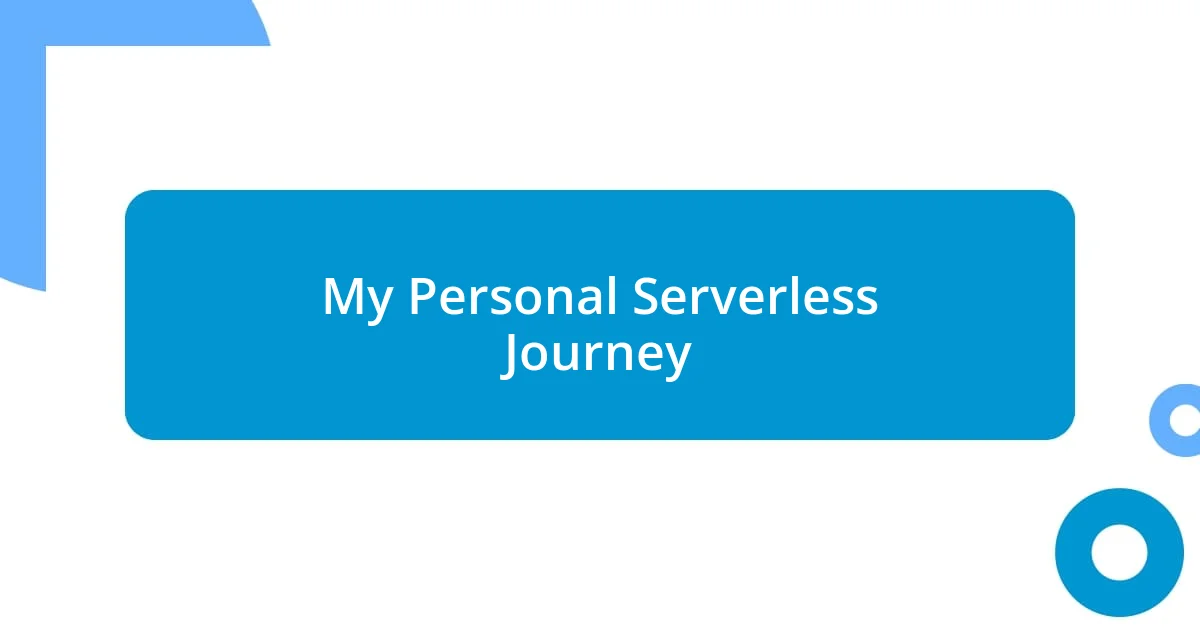
My Personal Serverless Journey
My adventure with serverless architectures began with curiosity and a hint of skepticism. When I first encountered AWS Lambda, it felt like walking into a playroom filled with cool gadgets. I excitedly deployed my first function, but that rush quickly became confusion as I tried to grasp how all the pieces fit together. Have you ever felt exhilarated yet overwhelmed at the same time? It’s a unique mix, and I think it’s essential in the journey of learning.
As I continued exploring, I stumbled on an unexpected roadblock. While integrating multiple APIs into a single function, the result was a convoluted mess that made debugging feel like searching for a needle in a haystack. It was both frustrating and humbling. I realized that less is often more; granular functions were not just a best practice but a crucial mindset shift that transformed my entire approach. I often think about how vital it is to embrace simplicity in complexity — don’t you think that’s a lesson for life as well?
The real turning point in my serverless journey came when I automated my deployment process. I distinctly remember the sense of relief washing over me when I saw my CI/CD pipeline whirring to life, handling everything magically behind the scenes. It changed my perspective on project timelines and reduced stress significantly. Have you ever experienced that exhilarating moment when everything just clicks into place? Those small wins in the development process foster not just productivity, but also a deeper passion for what you create.














